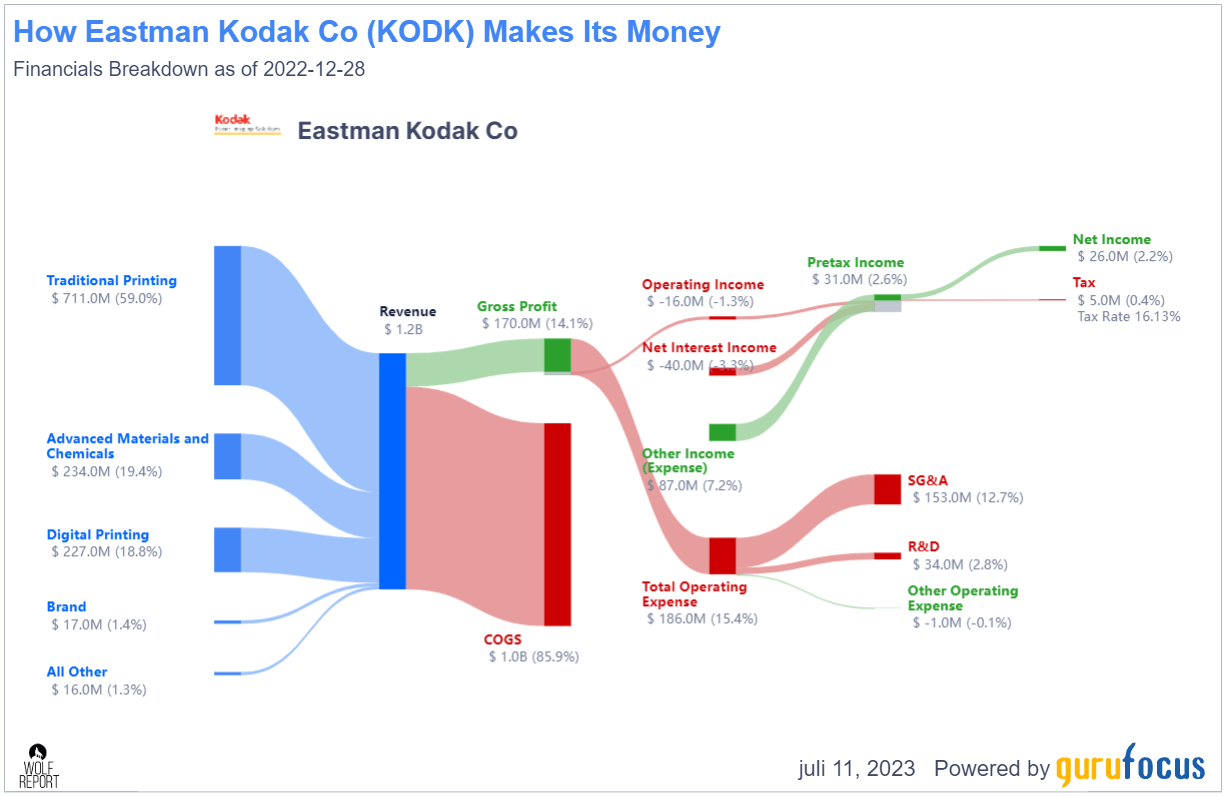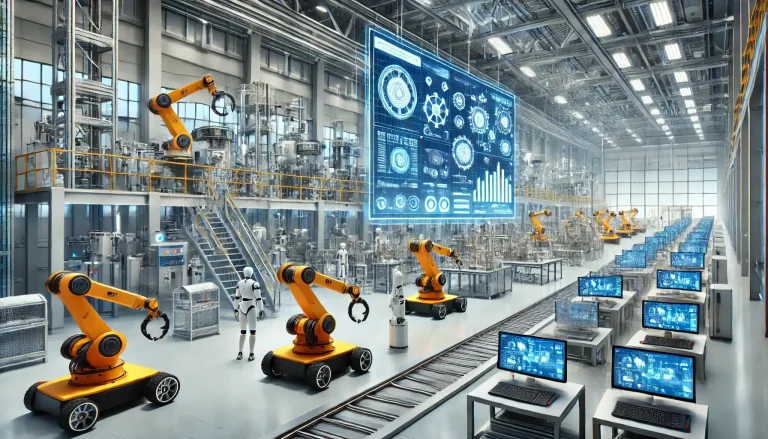Eastman Kodak Navigates Market Stability on the NYSE Composite with Kalkine Media Insights

Reimagining Industrial Modernization in a Changing Global Economy
In today’s dynamic business environment, industries across the board are experiencing a significant transformation. Companies like Eastman Kodak, once known primarily for traditional film, have redefined themselves by embracing innovation in imaging, materials, and chemical solutions. This shift is not just about reinventing products—it marks a broader evolution in industrial manufacturing, where technology-based advancements are reshaping the very nature of global production. As we witness these changes, it becomes essential to get into the fine points of this transformation, particularly when it comes to the business tax laws, economic news, and the intricate world of small business and industrial manufacturing.
The evolution of firms such as Kodak is a story of adaptation, where the need to figure a path through new markets has required solving the confusing bits of traditional business models. Moreover, when these changes co-occur with the rising tide of disruptive industrial trends—like electric vehicles and advanced auto technology—the stakes become even higher. In an era where the twists and turns of modern commerce can be somewhat intimidating, it is crucial to step back and poke around the factors driving this industrial renaissance.
Industrial Manufacturing’s Role in a Tech-Driven Era
Innovation in imaging, materials, and chemical solutions is just one facet of industrial modernization. Manufacturing enterprises across the globe are increasingly reliant on technological breakthroughs to stay competitive. With companies revisiting and reinventing their operational methods, the transformation is as much about revising traditional processes as it is about adopting entirely new technologies.
In the case of Eastman Kodak, the transition from a film-centric company to a diversified technology powerhouse illustrates the potential for reinvention in industrial sectors. The company’s pivot underscores the need for established firms to address the tangled issues of legacy systems while also preparing for a future that is super important to both large and small business interests. When we take a closer look at these patterns, we see that successful adaptation requires a blend of risk-taking and analytical precision, allowing companies to sort out the nerve-racking dilemmas that come with transformative change.
Adapting to Changing Customer Needs in Industrial Manufacturing
Traditional manufacturing methods are being supplemented—or even replaced—by a host of emerging digital technologies. These technologies enable companies to manage their way through supply chain challenges and reduce operational delays. One of the key drivers behind this revolution is rapid technological progress, which allows enterprises to shift away from legacy systems that are full of problems and toward more agile, digitally inclined solutions.
Given these developments, leaders in the industrial and manufacturing sector are now forced to take the wheel through several stages of innovation:
- Integrating digital manufacturing platforms
- Optimizing production processes using real-time data
- Investing in advanced materials research
- Collaborating with tech startups to foster innovation
- Streamlining supply chain logistics through automation
Each of these steps involves handling tricky parts of change management, where making your way through important details can be challenging for even the best-run organizations. This reality is especially true for traditional companies that must re-engineer processes while keeping an eye on profitability and regulatory requirements.
Electric Vehicles and the Auto Industry’s New Frontier
The move toward a cleaner, more efficient automotive sector is transforming the electric vehicle (EV) market. Investors and entrepreneurs alike are staring at the auto industry with a mix of excitement and caution. The transition to EVs is not without its nerve-racking challenges; however, it is a necessary evolution that involves both exciting innovations and difficult adjustments.
Electric vehicles stand out as a super important part of the industrial advancement narrative. They embody the spirit of modern innovation, addressing environmental concerns while also pushing technological boundaries. As we take a closer look at the EV sector, several themes emerge:
- Infrastructure demands: Developing extensive charging networks and upgrading grid systems
- Battery technology advances: Focusing on increased energy density and faster charging times
- Supply chain considerations: Securing ethical and sustainable sources for critical materials such as lithium and cobalt
- Regulatory shifts: Adapting to new incentives and emission standards in different regions
- Consumer acceptance: Overcoming off-putting misconceptions about range and reliability
Each of these points involves its own set of confusing bits and tricky parts that companies need to manage. Industry leaders must figure a path that balances technological possibilities with practical market realities—a task that requires clear strategy and a willingness to experiment with new business models.
The Impact of Auto Technology on Broader Economic Trends
Electric vehicles are more than just a technological marvel; they are a symbol of a shifting economic paradigm. As governments implement business tax laws that favor clean energy and sustainable practices, the auto industry finds itself at an exciting yet challenging crossroads. Economic news often highlights the struggles and successes of this sector, with many experts arguing that the auto market is one of the key indicators of broader economic health.
Breaking this topic down into simpler terms, let’s consider some of the critical factors driving the electric vehicle revolution:
| Driving Factor | Key Considerations | Implications for the Market |
|---|---|---|
| Government Incentives | Tax breaks, subsidies, and rebates for EV buyers | Boosts consumer demand while reducing overall emissions |
| Technological Innovation | Advances in battery performance, connectivity, and autonomous driving | Enhances safety, efficiency, and the overall user experience |
| Consumer Trends | Increased environmental awareness and demand for sustainable transport | Shifts in buying patterns towards green alternatives |
These trends underscore the need for collaboration between policymakers, manufacturers, and technology innovators. With the EV sector gaining momentum, there is no doubt that auto technology is set to have far-reaching impacts on everything from manufacturing practices to public policy, and even small business strategies.
Small Business Resilience in a Rapidly Evolving Economic Landscape
Moving beyond the giants of industrial manufacturing or auto tech, small businesses play a crucial role in the overall economic ecosystem. They showcase the spirit of entrepreneurship and are often quick to pivot in response to environmental shifts. However, the journey is often intimidating for many small business owners because it is riddled with challenges such as unpredictable market trends and ambiguous regulatory frameworks.
For small business operators, the day-to-day realities involve sorting out factual details that might appear full of problems. Many face off-putting administrative challenges related to tax compliance and bookkeeping as they shift from traditional revenue streams to more modern, tech-enabled platforms.
Overcoming Business Tax Law Hurdles
Business tax laws are a key area that demands extra attention from small business owners and managers alike. Getting into the nitty-gritty of these laws is necessary for avoiding unforeseen financial pitfalls. With tax regulations continually evolving—especially with new policies aimed at promoting sustainable practices—the challenge is both critical and stressful.
Business owners might find the following checklist helpful when trying to figure a path through changing tax legislation:
- Stay updated with recent government announcements and policy changes
- Consult with financial advisers who specialize in business taxes
- Utilize accounting software that is designed to manage intricate tax details
- Attend industry seminars and webinars to keep abreast of the latest trends
- Regularly review and update your business’s tax strategies
The importance of taking these steps cannot be overstated. Even though the fine points of tax law may sometimes involve nerve-racking details, ensuring compliance can save a business from costly mishaps and provide a stable foundation for growth.
Marketing in an Age of Digital Transformation
The marketing landscape for small businesses is another arena where evolution is not just necessary—it’s imperative. As customer behavior shifts towards online platforms and digital experiences, traditional marketing techniques must be reimagined. To truly succeed, small businesses need to get into the subtle parts of digital marketing, exploring social media, search engine optimization, and content marketing strategies.
Key areas to consider for modern digital marketing include:
- Social Media Engagement: Building an authentic connection with customers on platforms like Instagram, Facebook, and LinkedIn
- Content Strategy: Creating informative and engaging content that resonates with a tech-savvy audience
- SEO Best Practices: Using well-researched keywords to improve online visibility and drive traffic to company websites
- Email Marketing: Nurturing leads and maintaining customer relationships through well-crafted email campaigns
- Analytics and Feedback: Continuously evaluating campaign performance and making adjustments based on data insights
While the challenges of embracing digital marketing might be overwhelming at first, the benefits are clear. In a world where consumers increasingly rely on digital sources for information, adapting your marketing strategy is not just beneficial; it’s key to long-term success.
The Intersection of Industrial Innovation and Economic News
As industries modernize, economic news outlets are paying closer attention to the narratives that drive these changes. Breaking news about industrial innovations can have ripple effects that reach far beyond the manufacturing floor. Reports on advancements in technology frequently highlight both successes and the tricky parts that companies face as they manage their way through the evolving market landscape.
For example, discussions around companies like Eastman Kodak emphasize the remarkable ability of legacy firms to reinvent themselves. These businesses face the challenge of managing their way through traditions that are on edge while simultaneously pushing forward with essential innovations. Economic analysts are increasingly observing that the broader market stability depends not only on technological prowess but also on the ability to negotiate business tax intricacies and foster a supportive regulatory environment.
How Global Economic Events Affect Industrial Manufacturing
Global economic news often captures the intertwined fate of various sectors. Industrial manufacturing, although traditionally seen as a slower-changing industry, is now subject to international influences such as:
- Fluctuating commodity prices impacting production costs
- Shift in labor market dynamics and workforce trends
- Trade policies that often become loaded with issues and political contention
- Regulatory shifts meant to encourage technological innovation
- Environmental policies that influence both production methods and product design
Even though each of these factors involves its own set of intimidating details, together they form a complex mosaic of modern industry challenges. Economic news rightly hones in on these elements because they have the potential to either propel growth or hinder development if not addressed in a strategic manner.
It is essential for stakeholders in industrial sectors to work through these challenges by engaging in open dialogue with policymakers, business leaders, and industry experts. By taking the time to sort out fine shades of policy details, companies are better positioned to steer through the economic landscapes that define our current era.
Evolving Business Strategies in a Time of Technological Change
In this rapidly evolving economic scenario, success no longer hinges solely on the ability to mass produce goods—it is increasingly dependent on innovation, digital adoption, and savvy business strategies. Companies that manage to make their way through technological changes often embrace comprehensive innovation strategies that touch on everything from production methods to customer engagement and tax compliance.
Many business leaders are now calling for an integrated approach that addresses several key components simultaneously. These include investing in research and development, refining operational processes using digital tools, and building resilient networks that can handle both market volatility and regulatory uncertainties. The ultimate goal is to foster growth while mitigating risks, a task that involves dealing with the confusing bits of modern market challenges.
Strategic Pillars for Future-Proofing Your Business
To remain competitive in an environment marked by evolving market demands and regulatory shifts, businesses—both large and small—must align their strategies around several strategic pillars. Consider the following framework as a guide:
- Innovation: Adopt technologies that streamline operations and open new avenues for revenue.
- Digitization: Transition from traditional approaches to digital-first strategies in marketing, supply chain, and customer engagement.
- Compliance: Regularly review and adjust business operations in line with updated tax laws and regulatory standards.
- Sustainability: Incorporate eco-friendly practices that align with government incentives and shifting consumer expectations.
- Agility: Develop flexible business models that allow for rapid adaptation amid market fluctuations.
While each strategic pillar involves its own challenges and confusing bits, the synergy between these elements can empower organizations to build profitable and resilient business models. The journey may be full of intricate decision-making, but with clear goals and well-researched insights, it is a path that countless businesses are already successfully treading.
Exploring the Future of Business Tax Opportunities and Challenges
In our discussion of industrial evolution and technological advancements, it is impossible to ignore the significant role of business tax laws. As governments across the globe implement new policies to promote sustainable practices and innovation, these legal frameworks are having a profound effect on business strategy. For many companies, especially small businesses, figuring a path through the tricky parts of tax regulations is both a necessity and a potential source of competitive advantage.
Modern tax reforms aim to create a more balanced environment for both established corporations and new market entrants. These changes are super important because they lay the groundwork for a more transparent and supportive economic framework. However, the path forward is often full of confusing bits and off-putting procedures that can seem overwhelming at times. By taking a closer look at the evolving landscape of business taxes, companies can find ways to turn these challenges into strategic opportunities.
Key Considerations for Business Tax Strategy in 2025
As we move further into a global economy defined by digital transformation and industrial innovation, keeping up with tax regulations is critical. Here are some key considerations that business leaders should keep in mind:
| Consideration | Description | Strategic Benefit |
|---|---|---|
| Regulatory Updates | Monitoring changes in tax laws that specifically affect technology and manufacturing sectors. | Prepares businesses to adjust financial strategies ahead of time. |
| Digital Tools | Leveraging accounting software and expert systems to manage tax information with precision. | Reduces the likelihood of expensive compliance errors. |
| Professional Advice | Regular consultations with tax professionals to clarify the small distinctions in new regulations. | Ensures that companies are not left exposed on critical missteps. |
| Incentive Programs | Utilizing government incentives for sustainable business practices and technological innovation. | Can result in meaningful financial benefits and enhanced market reputation. |
By actively engaging with these considerations, companies of all sizes can manage the tangled issues of tax compliance more effectively. Although the process can sometimes be intimidating, a well-crafted tax strategy can be a must-have asset in driving long-term growth.
A Multifaceted Approach to Economic Modernization
Industrial modernization is not a standalone phenomenon—it exists at the intersection of evolving markets, regulatory landscapes, and shifting consumer demands. With businesses worldwide having to figure a path through the twists and turns of technological advances and complex tax reform, the need for thoughtful strategy and robust adaptation mechanisms has never been greater.
The journey toward modern economic practices is full of off-putting challenges, from the nerve-racking details of tax laws to the complicated pieces of technological disruption. Yet, by remaining vigilant and proactive, companies can not only survive but thrive in an era marked by transformational change. This multifaceted approach requires leaders to keep a close eye on both the big picture and the subtle details, ensuring that every strategic decision is backed by reliable data and sound reasoning.
The Role of Collaboration and Innovation
The future of industrial modernization will likely hinge on the ability of companies to collaborate across sectors. Whether it is aligning with government bodies on regulatory reforms or partnering with tech startups to foster innovation, working through sympathetic collaborations has become critical. Shared knowledge networks and public-private partnerships provide essential support, enabling businesses to effectively address the hidden complexities of modern markets.
Collaboration offers several benefits:
- Shared Expertise: Combining industry experience with cutting-edge research.
- Cost Reduction: Pooling resources to tackle common issues such as supply chain disruptions.
- Risk Mitigation: Working together to anticipate and manage potential pitfalls.
- Market Expansion: Accessing broader networks for market research and development.
These advantages not only help individual companies but also contribute to a more robust and resilient economic environment overall. Though the combined forces of industrial growth and digital transformation can be intimidating, coordinated efforts provide clear routes to overcoming the challenging bits of today’s business world.
Integrating Traditional Expertise with Modern Digital Methods
Many of the time-tested practices in industrial manufacturing, automotive production, and small business management are now getting a digital twist. The ability to mix traditional expertise with modern digital methods is a key factor in staying responsive to the constantly shifting economic landscape. This blend of old and new is particularly evident in companies that have managed to transition smoothly—like Eastman Kodak—demonstrating that even legacy brands can reinvent themselves.
Traditional methods provide the stability and familiarity that many businesses rely on, while digital solutions introduce flexibility and speed in responding to market conditions. The combination of these approaches can be summarized as follows:
- Legacy Knowledge: Valuing long-established operational procedures and industry experience.
- Digital Optimization: Leveraging data analytics, artificial intelligence, and automated systems to streamline processes.
- Customer-Centric Models: Utilizing social media and online platforms to gather feedback and tailor products or services accordingly.
- Adaptive Strategy: Combining steady traditional methods with innovative digital tactics to address the challenging bits of modern economic shifts.
This combined approach also emphasizes the importance of understanding the small distinctions in customer behavior, allowing businesses to remain agile while ensuring that every new technological step is grounded in practical, real-world applications.
Conclusion: Charting a Course Through a Transforming Landscape
As we dig into the evolving landscape of industrial manufacturing, automotive innovation, and small business resilience, it is clear that the modern economic environment demands a multifaceted and adaptable approach. Companies are now challenged to balance traditional practices with digital innovation, all while contending with off-putting regulatory changes and nerve-racking tax complexities. The story of Eastman Kodak’s reinvention stands as a testament to the power of innovation and resilience, inspiring other industries to figure a path that harmonizes technological advancements with established business values.
Whether you are a small business owner navigating the twists and turns of unexplored markets or a leader in industrial manufacturing steering through toxic regulatory environments, the key takeaway is to remain agile, informed, and collaborative. Embracing both legacy expertise and modern digital strategies will allow your organization to thrive amidst the evolving intricacies of our global economy. Together, we can work through the tangled issues of traditional practices while seizing super important opportunities brought on by technological breakthroughs and innovative tax policies.
In this interconnected world, the future of business hinges on the capability to adapt and excel. From electric vehicles redefining the auto industry to traditional companies reinventing themselves in the face of digital disruption, the path forward is clear: continuous innovation, strategic planning, and collaboration are vital to overcoming every tricky part and intimidating challenge dominating today’s economic narrative.
As you consider the transformations occurring around you, remember that every shift—no matter how overwhelming—holds the promise of renewed growth and opportunity. The journey might involve many confusing bits and complicated pieces, but with the right support, insights, and strategies, every business can not only find its way but also lead the charge into a smarter, more sustainable future.
Industry leaders and policymakers alike would do well to take these observations to heart. The dialogue around industrial modernization, digital transformation, and evolving tax laws is not just academic—it is the lifeblood of our modern economy. By embracing these challenges with a balanced approach that respects both tradition and innovation, we can ensure that our economic future is as resilient as it is transformative.
Ultimately, the road ahead is full of promising innovations and exciting opportunities. With careful planning, collaborative spirit, and a willingness to dive into every small twist and fine shade of detail, companies of all sizes can steer through this new era with confidence. Now more than ever, staying on top of the confusing bits and managing your way through the tangled issues of industrial and economic change is essential. By doing so, we pave the way for a future where growth, sustainability, and prosperity go hand in hand.
As we chart our course through these exciting times, it is clear that success will belong to those who are not afraid to experiment and innovate, who remain connected to both the past and future of business. The evolution of industrial manufacturing and its allied sectors serves as a powerful reminder that in today’s fast-changing world, embracing change and strategically planning for the future is the key to unlocking growth and economic stability for everyone.
Originally Post From https://kalkinemedia.com/us/stocks/industrial/eastman-kodak-nysekodk-nyse-composite-market-stability
Read more about this topic at
Innovation
How Kodak evolved to tackle seismic changes in the print…





